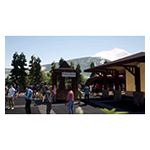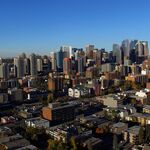Mountain Man
Senior Member
Mind boggling that we don't have a rail connection to Banff, this is a no brainer.

from the article:
Calgary Airport - Banff Passenger Rail Project Completes 11 Key Components of First Stage of Design Phase, Potential to Enhance Liricon/Plenary Proposal
Liricon Capital Ltd. (Liricon) and Plenary Americas (Plenary), a portfolio company of Caisse de dépôt et placement du Québec (CDPQ), are pleased to announce ...www.businesswire.com

Calgary Airport - Banff Passenger Rail Project Completes 11 Key Components of First Stage of Design Phase, Potential to Enhance Liricon/Plenary Proposal
Liricon Capital Ltd. (Liricon) and Plenary Americas (Plenary), a portfolio company of Caisse de dépôt et placement du Québec (CDPQ), are pleased to announce ...www.businesswire.com
It has every penny of the recurring provincial subsidy; $3,000,000,000 of taxpayer money. They've done a great job of getting high powered people to say that they're happy for the other people's money to be spent on this project; that means they have a good rolodex, nothing more. The ridership projections seem like pure fiction to me, especially given that there isn't enough design to say what service the train will actually provide. They managed to triple their previous projection for airport ridership through hidden magic, even though their previous projection was both simplistic and optimistic.Eliminating the need for a recurring provincial subsidy is a huge win. The AB government and Parks Canada should be all over this now!
But how does a train produce that? The entire Rocky Mountains (Banff/Canmore/Louise/Kananaskis/Jasper) are already at 93% hotel occupancy prepandemic in the peak season (compare - the province as a whole is at 63% in the summer and 54% year round). The primary way that out of province tourism can increase is by building more hotels - which is both completely independent of a train and strongly opposed by locals. It doesn't matter how easily you get there if there's nowhere to stay. I suppose there's potential for a marginal increase in international travel that prices out locals even more, but that doesn't seem all that desirable as a local who doesn't make their money directly from Banff tourism.Meh. The increased out of province tourism visitation nights is the payoff for me. More than fine with the investment.
The study a few years back was boosting Calgary visitation by joining the trips. Plus perhaps incenting larger hotels if Parks Canada can be reasonably assured the additional room won't mean an additional car.But how does a train produce that? The entire Rocky Mountains (Banff/Canmore/Louise/Kananaskis/Jasper) are already at 93% hotel occupancy prepandemic in the peak season (compare - the province as a whole is at 63% in the summer and 54% year round). The primary way that out of province tourism can increase is by building more hotels - which is both completely independent of a train and strongly opposed by locals. It doesn't matter how easily you get there if there's nowhere to stay. I suppose there's potential for a marginal increase in international travel that prices out locals even more, but that doesn't seem all that desirable as a local who doesn't make their money directly from Banff tourism.
Am I the only person who doesn't think the two main problems with Banff are it's not crowded enough and it's too cheap?
Entirely understand that it doesn't feel like how we would normally want a project like this to feel if it was government led.I like it, the case for a train makes sense - I just get real monorail vibes from this proposal sometimes though. It's all sales pitches and no meat. What's the speed? How frequent is the service? What the route alternatives if CP doesn't play ball as nicely as they imagine? How does it integrate with public transport systems at the stations? What experience do these proponents have in delivering or operating rail in any capacity? What about billion dollar projects?
I don't think this would happen in this province (both politically and the lack of institutional know-how to build anything apart from highways) but this strikes me as this should be a provincial transportation project with federal support and private involvement. I don't really get how they can overcome all the inter-jurisdictional issues without a larger leading role from a layer of government capable of stitching this all together into a coherent transportation system. Of course, governments have a mixed track record in transit delivery too - but this is literally and area where they are uniquely positioned and empowered to sort out.
And maybe the province, federal government and municipalities have all been involved extensively - it just doesn't feel that way as all we get seems to be more sales pitches from these proponents.
Entirely understand that it doesn't feel like how we would normally want a project like this to feel if it was government led.
But it is entirely on land with secured agreements from the landholders (the airport, CP). Has letters of support from all the municipalities along the way "securing support from affected municipalities/governments", and begun engagement with the Stoney Nakoda. If the province was leading this, they would similarly hire consultants and contract out nearly everything, so how is this different?
In the end there is no risk to the province. Why not give it a try?
The Calgary location will hopefully be better than the province's setaside lands: "Liricon/Plenary’s MOU with the City of Calgary is focused on station location to provide optimum integration with existing and planned transit systems."
As for system performance we have a few things:
- Airport to Downtown Rail Connection: travel time 15 minutes, frequency every 10 minutes (in the humongous press release), $10 fare for locals
- Downtown to Banff every 2 hours (heard this at a lunch last year, may have been revised up), $20 fare for locals (I'd imagine travel time isn't much faster than the original study done by the town of Banff (somewhere between 1 hour 40 minutes and 1 hour 52 minutes),
That isn't a problem with CP though - if the cost is too high, the project dies because the proponent can't make money. The starting point was double track with additional sidings. If there is a showstopper, its gotta be in the unknowns unknowns at this point.They have an MOU with CP. That is not a “secured agreement”. My guess is it says something like “we will work together to study this proposal”. When they inevitably determine that it’s not cost effective or practical to double track every km of the proposal, then the cost negotiations start.
That isn't a problem with CP though - if the cost is too high, the project dies because the proponent can't make money. The starting point was double track with additional sidings. If there is a showstopper, its gotta be in the unknowns unknowns at this point.
It is ok to believe the project will fail. But that isn't a reason to as a public to stop the project now, when the risk is on the private proponent.




